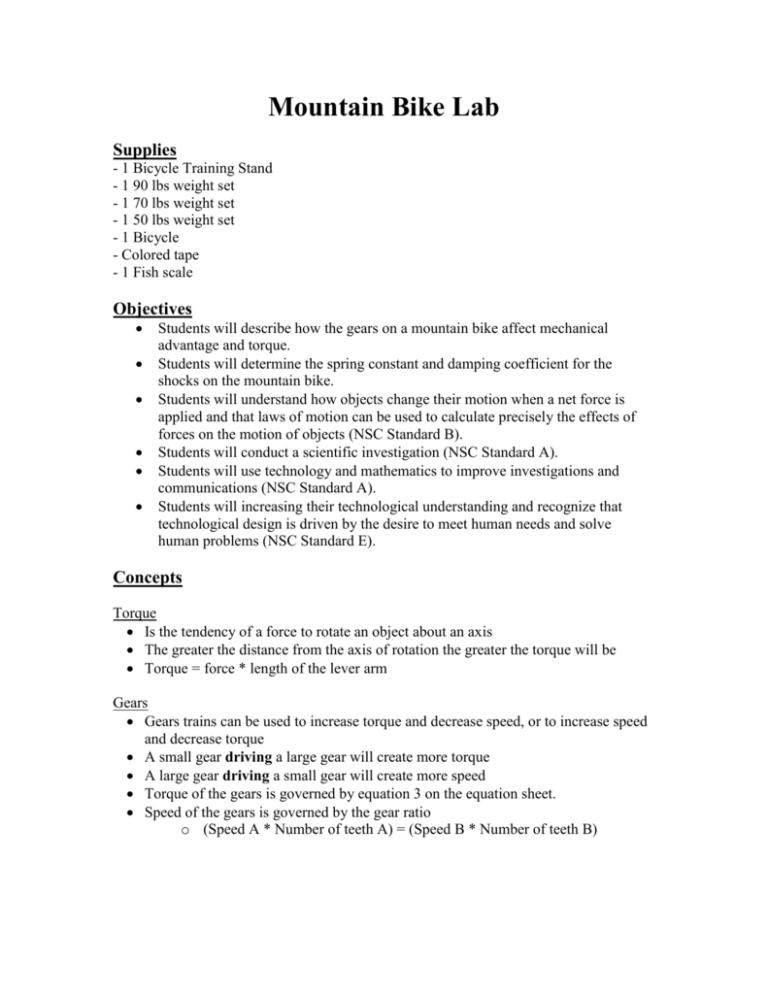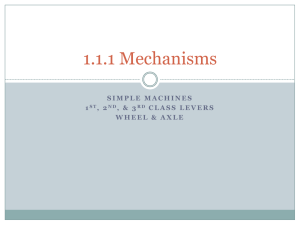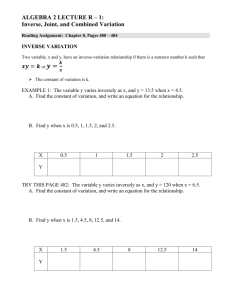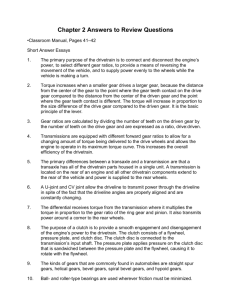WD013-013.6_DU Engineering of Extreme
advertisement

Mountain Bike Lab Supplies - 1 Bicycle Training Stand - 1 90 lbs weight set - 1 70 lbs weight set - 1 50 lbs weight set - 1 Bicycle - Colored tape - 1 Fish scale Objectives Students will describe how the gears on a mountain bike affect mechanical advantage and torque. Students will determine the spring constant and damping coefficient for the shocks on the mountain bike. Students will understand how objects change their motion when a net force is applied and that laws of motion can be used to calculate precisely the effects of forces on the motion of objects (NSC Standard B). Students will conduct a scientific investigation (NSC Standard A). Students will use technology and mathematics to improve investigations and communications (NSC Standard A). Students will increasing their technological understanding and recognize that technological design is driven by the desire to meet human needs and solve human problems (NSC Standard E). Concepts Torque Is the tendency of a force to rotate an object about an axis The greater the distance from the axis of rotation the greater the torque will be Torque = force * length of the lever arm Gears Gears trains can be used to increase torque and decrease speed, or to increase speed and decrease torque A small gear driving a large gear will create more torque A large gear driving a small gear will create more speed Torque of the gears is governed by equation 3 on the equation sheet. Speed of the gears is governed by the gear ratio o (Speed A * Number of teeth A) = (Speed B * Number of teeth B) Spring constant The force exerted by the spring is directly related to the displacement times the spring constant Linear materials use Hooke’s law of F=k*x o F = force o k = spring constant o x = distance the spring has been compressed or stretched Units are force per unit length (SI is Newton meters) Damping Coefficient, c Damping Coefficient determines how damped (responsive) a shock is or how long a shock will oscillate if at all Units of mass per unit time System can be (Fig 3) o Underdamped ( < 1) Lots of oscillations Ex. Rubber band o Critically damped ( = 1) No oscillations, but moves quickly Ex. Car shocks o Overdamped ( > 1) No oscillations, but moves slowly Ex. Door damper Equation relating spring constant and mass to damping coefficient o c=*2*(k*m)(1/2) o k = spring constant, m = mass Part 1: Mechanical Advantage and Torque 1. Count the number of teeth on the largest and the smallest chain ring of the front (driver) gears. Use the colored tape to help you keep track of where to start and stop counting. Enter these values in the tables on the attached sheet. 2. Count the number of teeth for at least three of the gears in the back (cassette) and record these values in the tables below. Try counting for the biggest, smallest, and a medium gear. When you are finished, each blank in the first two columns of each table should be filled in, giving you six gear combinations. 3. Measure the length (l) of the arm of the pedal. Measure from the center of the crank to the center of the pedal. Record this length below. Later, you will need this value to determine the torque using Equation 2 from your Equation Sheet. l = __________________ 4. Attach the fish scale to a pedal and pull on it at a 90 degree angle from the pedal arm. Use the scale to determine how much mass is required to start the wheel turning. Make sure to record in kilograms (kg). Repeat this process for each combination of gears. Use equation 4 to convert the mass to force and record the necessary force for each combination in the tables below. For simplification, assume the acceleration is gravity. 5. Calculate the mechanical advantage for each of the gear combinations using Equation 1 from your Equation Sheet. Record each mechanical advantage in the tables. 6. Using the length (l) and the force you recorded in the previous step, calculate the experimental torque for each combination of gears using Equation 2 from your Equation Sheet. Enter these values in the tables. Make sure to have the correct units i.e. keep cm, and meters straight. 7. Using the data that you have recorded in your table and Equation 1 from your Equation Sheet, find the output torque of the bicycle. Record this information in the tables. Part 1 Data Tables Number of Teeth Back Big Front Gear Gear Mechanical Advantage Force Experimental Torque Output Torque Number of Teeth Small Front Back Gear Gear Mechanical Advantage Force Experimental Torque Output Torque Part 2: Spring Constant and Damping Coefficient 1. Position your yardstick parallel to the bicycle shock and measure the height of the upper edge of the shock. Record this uncompressed length below as xlong. xlong = _________________________ 2. Add 50 lbs, 70 lbs, or 90 lbs of weight to the bicycle by loading equal amounts on each side of the handle bars (two 25 lb weights = 50 lbs, etc). Make sure to put both weights on and take both weights off at the same time to prevent from tipping the bike. 3. Now that you have weighted the bicycle, use your yardstick to measure the height of the shock as you did in step 1. Record this compressed length, xshort, in the appropriate space below. Make sure to have the correct units i.e. keep cm, and meters straight. 22.68 kg xshort = ___________________________________ 31.75 kg xshort = ___________________________________ 40.82 kg xshort = ___________________________________ 4. Determine the force that you applied to the shock using the equation 4. Record the force in the appropriate space below. 22.68 kg F =___________________________________ 31.75 kg F =___________________________________ 40.82 kg F =___________________________________ 5. Use Equation 5 from your Equation Sheet and the data you have collected so far to determine the spring constant (k) for the bike. Record this value in the appropriate space below. 22.68 kg k = ___________________________________ 31.75 kg k = ___________________________________ 40.82 kg k = ___________________________________ 6. Repeat steps 2-5 with all 3 different sets of weight, filling in your lab sheet as you go. 7. Assume that the damping ratio ( is equal to 1 (the system is critically damped). Use Equation 6 from your Equation Sheet to find the damping coefficient c for the bike. Record this information in the appropriate space below. 22.68 kg c = ___________________________________ 31.75 kg c = ___________________________________ 40.82 kg c = ___________________________________ 8. Now find the average k and c values for the bicycle and record these values below. Average k = ___________________________________ Average c = ___________________________________ Questions 1. How are the output and experimental torques related? 2. What was the largest mechanical advantage you could achieve with the bike? How would this affect the resistance of your pedaling and the wheel speed? 3. What was the smallest mechanical advantage? How would this affect the resistance of your pedaling and the wheel speed? 4. What would happen if you increased k on the bike? 5. What would happen if you increased c on the bike? 6. How could bicycle manufacturers use what you have learned through this lab? Equation Sheet eq 1 N1 MA MA = mechanical advantage N2 N1 = number of teeth on driven gear (back gear) N2 F l eq 2 T eq 3 N1 T1 N2 T2 eq 4 F = number of teeth on driver gear (front gear) T = torque (N*m), F = Force (N) , l=length (m) T1 = output torque (N*m) T2 = experimental torque applied (N*m) N1 = number of teeth on gear 1 m a m = mass (kg) N2 = number of teeth on gear 2 a = acceleration (gravity) a 9.807 m s eq 5 F k x F=force (N), k=spring constant eq 6 c 2 k m = damping ratio eq 7 2 r1 N1 T1 1 r2 N2 T2 k=spring constant master equation x 2 xlong xshort m = mass (kg) (m) This workforce solution was funded by a grant awarded under the Workforce Innovation in Regional Development (WIRED) as implemented by the U.S. Department of Labor’s Employment and Training Administration working in partnership with the Colorado Department of Labor and Employment, the Metro Denver Economic Development Corporation, and the City and County of Denver's Office of Economic Development. The solution was created by the grantee and does not necessarily reflect the official position of the U.S. Department of Labor. The Department of Labor makes no guarantees, warranties, or assurances of any kind, express or implied, with respect to such information, including any information on linked sites and including, but not limited to, accuracy of the information or its completeness, timeliness, usefulness, adequacy, continued availability, or ownership. This solution is copyrighted by the institution that created it. Internal use by an organization and/or personal use by an individual for non-commercial purposes is permissible. All other uses require the prior authorization of the copyright owner.








